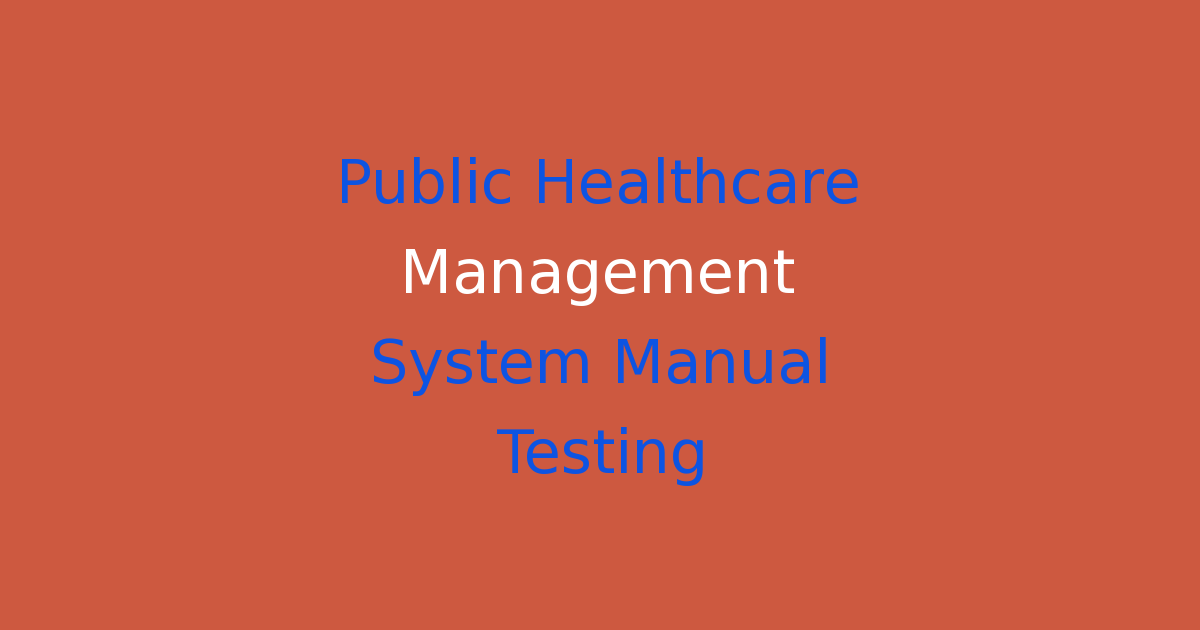Manual testing of the public healthcare management system.
Public Healthcare Management System Manual Testing
Introduction
In the field of healthcare management, manual testing plays a crucial role in ensuring the effectiveness and efficiency of public healthcare systems. Manual testing is the process of manually reviewing software applications to identify defects and issues that could impact the system’s performance. In this project, we will focus on the manual testing of public healthcare management systems in India, with the aim of improving the quality of healthcare services provided to the public.
Problem Statement
The current public healthcare management system in India faces various challenges, including issues related to software defects, security vulnerabilities, and performance bottlenecks. These challenges can have a significant impact on the quality of healthcare services provided to the public, leading to delays in treatment, errors in patient records, and compromised patient data confidentiality.
Existing System
The existing public healthcare management system in India relies heavily on manual testing processes to ensure the reliability and functionality of the system. However, manual testing has its limitations, including the potential for human error, the time-consuming nature of the process, and the inability to replicate real-world scenarios accurately. As a result, the existing system may not be able to detect all defects and issues that could impact the system’s performance.
Disadvantages
Some of the disadvantages of the existing public healthcare management system manual testing include:
1. Human Error: Manual testing processes are prone to human error, which can lead to missed defects and issues in the system.
2. Time-Consuming: Manual testing is a time-consuming process, which can result in delays in identifying and fixing defects in the system.
3. Limited Scope: Manual testing may not cover all possible scenarios and conditions, leaving some defects undetected.
4. Lack of Reproducibility: Manual testing may not be able to accurately replicate real-world scenarios, making it challenging to assess the system’s performance in different environments.
Proposed System
To address the limitations of the existing public healthcare management system manual testing, we propose the implementation of an automated testing framework. Automated testing uses software tools and scripts to perform tests, allowing for the rapid and accurate identification of defects and issues in the system. By automating the testing process, we can improve the efficiency and effectiveness of healthcare management systems, leading to better quality of care for the public.
Advantages
Some of the advantages of implementing automated testing in public healthcare management systems include:
1. Increased Efficiency: Automated testing allows for faster and more thorough testing of the system, reducing the time and effort required for testing activities.
2. Improved Accuracy: Automated testing tools can accurately identify defects and issues in the system, leading to improved system performance and reliability.
3. Greater Coverage: Automated testing can cover a wide range of scenarios and conditions, ensuring comprehensive test coverage for the system.
4. Scalability: Automated testing frameworks can be easily scaled up to accommodate changes in the system, making it easier to maintain and update the testing process.
Features
Some of the key features of our proposed automated testing framework for public healthcare management systems include:
1. Test Automation: The framework will include tools and scripts for automating the testing process, allowing for fast and accurate testing of the system.
2. Test Coverage: The framework will cover a wide range of scenarios and conditions, ensuring comprehensive test coverage for the system.
3. Performance Testing: The framework will include performance testing tools to assess the system’s performance under different conditions.
4. Security Testing: The framework will include security testing tools to identify vulnerabilities and ensure the confidentiality of patient data.
Conclusion
In conclusion, manual testing of public healthcare management systems in India has its limitations, including human error, time-consuming processes, and limited scope. By implementing an automated testing framework, we can improve the efficiency and effectiveness of healthcare management systems, leading to better quality of care for the public. Automated testing offers advantages such as increased efficiency, improved accuracy, greater coverage, and scalability, making it a valuable tool for healthcare management in India. The proposed automated testing framework will include features such as test automation, test coverage, performance testing, and security testing, ensuring comprehensive testing of public healthcare management systems. By embracing automated testing, we can enhance the quality and reliability of healthcare services provided to the public, leading to better health outcomes for all.

